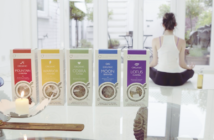Most of us use the terms “spice” and “herb” interchangeably. Herbs, however, are traditionally obtained from the leaves of herbaceous (non-woody) plants, while spices can be obtained from roots, flowers, fruits, seeds or bark and tend to be more strongly flavored. To add to the confusion, some plants produce both herbs and spices. An example is Coriandrum sativum. The leaves of this wonderful plant produce the herb cilantro while we get the spice coriander from the plant’s seeds.
Let’s take a look at spices and the role they place in a well-known tea blend we call Masala chai. The word chai is derived from the Sanskrit word for “tea”. Masala (spiced) chai is an ancient medicinal tea that combines black tea with spices traditionally used in Ayurveda, one of the oldest healing systems in the world, dating back more than 5,000 years.
On the web, you’ll find countless recipes for chai. The most commonly used spices in this tasty beverage include cardamom, ginger, cinnamon and cloves. It is the antioxidant effect of all these healing spices that is at the core of their medicinal value. Oxidation is a chemical reaction taking place in our body that produces free radicals that damage cells. Antioxidants interfere with this dangerous chain reaction. Our beloved plant, Camellia sinensis, which is part of chai in the form of black tea, is also known for having tremendous antioxidant capabilities. Research on black tea also links it with increased immune function and cardiovascular benefits.
Download our free Wellness & Tea 101 E-Book
Cardamom is noted as a safe and effective warming digestive aid, which some believe can also stimulate the mind and provide cognitive clarity. In Germany, an organization called the Commission E, much like our FDA but focusing on natural products, approved cardamom to treat indigestion. Cardamom is commonly used in Germany to treat colds, to quiet coughs, to soothe bronchitis, to reduce fevers, to treat liver and gallbladder complaints, to stimulate appetite, and to enhance the function of the immune system.
Ginger is another healing spice previously detailed (See “Wonderful Ginger,” in the May/June 2012 issue.) Ginger is excellent at combatting gas and also offers antifungal, antibacterial, antiviral and anti-nausea effects. In addition, there is evidence that ginger stimulates the circulatory system.
Cinnamon had been used for hundreds of years as a perfume but today is recognized as a gastrointestinal aide with antibacterial actions. It is believed to have a synergistic effect with other herbs and spices as it appears to increase or stimulate effectiveness of herbs used in conjunction with it. Recent investigation points to cinnamon’s potential benefits controlling blood sugar and as a sleep aide.
Clove contains a chemical component called eugenol which is currently being used as a dental analgesic. Folk lore recommends clove as a natural remedy for a toothache and as an effective agent to combat bad breath. Naturopaths report that clove is antiseptic, anti-parasitic, antifungal and antibacterial. They also recommend it during labor to strengthen uterine contractions.
Keep in mind that to have maximum health effects, the spices must be fresh. The inclusion of excessive amounts of sweeteners reduce this potential powerhouse of a beverage into a guilty pleasure. Why not instead find a chai recipe that makes a healthy brew that promises to improve your general health and wellness?
Most contemporary chai recipes call for a ratio of one part black tea to one part milk. Recent scientific investigation, such as that published in the European Journal of Nutrition, now cautions against the use of milk in tea. The simultaneous ingestion of dairy proteins and tea appear to reduce the bioavailability of catechins in the tea. It is the catechins that provide the antioxidant benefits of tea. This supports epidemiological studies that show Asian populations who drink tea without milk enjoy protective benefits from green tea consumption, while there is a lack of observable health benefits for the British population that is known to be consistent black tea with milk drinkers.
To maximize health benefits, one might want to seek out chai recipes without the emphasis on milk and sugary sweeteners.
Note that this post was previously published in 2012




